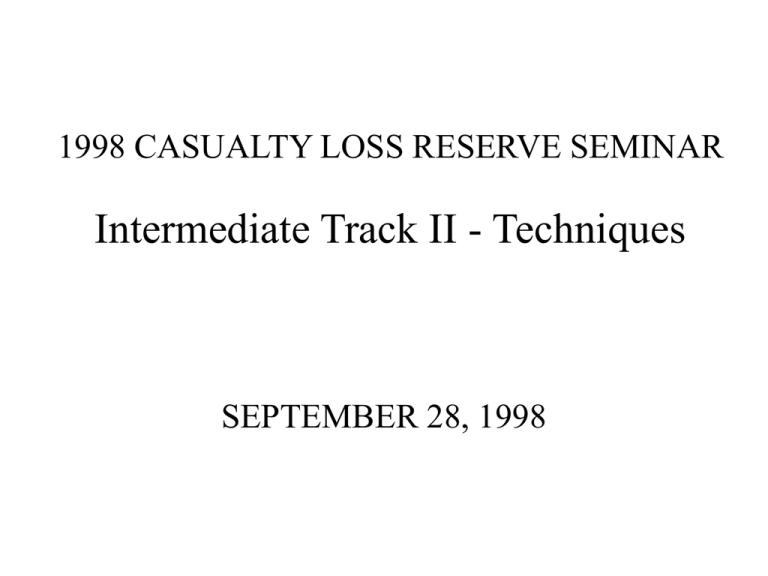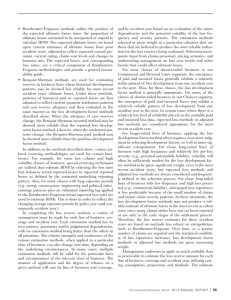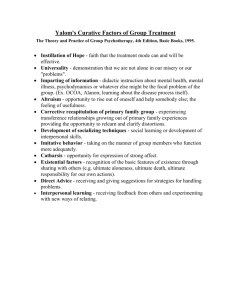Intermediate Track II - Techniques 1998 CASUALTY LOSS RESERVE SEMINAR
advertisement

1998 CASUALTY LOSS RESERVE SEMINAR Intermediate Track II - Techniques SEPTEMBER 28, 1998 RESERVE MODELS Average Hindsight Reserve Method (Slides 2 - 12) Average Incremental Paid Method (Slides 13 - 19) Bornhuetter-Ferguson Method (Slides 20 - 30) Slide 1 AVERAGE HINDSIGHT RESERVE METHOD Goal: Estimate The Average Future Settlement Value Per Claim For Recent Accident Years, Both For Claims Already Reported and Future Claim Reports . . Based On: Projected Ultimate Losses and Hindsight Average Values For More Mature Accident Years . Hindsight (Current Ultimate-Historical Payments) is the Implied Unpaid Amount Slide 2 . AVERAGE HINDSIGHT RESERVE METHOD Data Needed Cumulative Paid Loss Triangle Cumulative Closed (Paid) Claim Count Triangle Estimated Ultimate Number of Claims for All Accident Years Estimated Ultimate Losses For Several Mature Accident Years Slide 3 AVERAGE HINDSIGHT RESERVE METHOD XYZ Auto Insurance Company Cumulative Paid Losses ($000) Accident Year 12 1991 $50.0 1992 60.2 1993 75.5 1994 91.9 1995 115.0 1996 146.5 1997 181.1 *To be estimated Slide 4 24 $80.0 97.0 120.1 147.1 184.1 233.4 Months Of Development 36 48 60 72 $98.2 $107.8 $113.2 $117.2 118.5 130.7 136.6 141.0 147.0 162.4 171.0 180.2 197.0 226.4 . 84 Ultimate $119.7 $119.7 143.8 178.7 220.1 * * * AVERAGE HINDSIGHT RESERVE METHOD XYZ Auto Insurance Company Cumulative Number Of Closed Claims Accident Year 1991 1992 1993 1994 1995 1996 1997 12 50 55 63 70 80 93 105 24 75 83 94 105 120 139 Months Of Development 36 48 60 88 94 97 97 104 107 110 118 122 123 131 141 *Estimated using claim count development factors. Slide 5 . 72 99 109 84 100 Ultimate* 100 110 125 140 160 185 210 AVERAGE HINDSIGHT RESERVE METHOD XYZ Auto Insurance Company Calculation Of Average Outstanding Losses At 36 Months Purpose: Project Future Settlement Dollars For 1995 Estimated Paid Accident Ultimate Losses at Year Losses 36 Months . (1) (2) 1991 $119,700 1992 143,800 1993 178,700 1994 220,100 (3) (4) (5) (6) $98,200 118,500 147,000 180,200 $21,500 25,300 31,700 39,900 100 110 125 140 88 97 110 123 *Includes IBNR Claims Slide 6 Number Estimated Estimated Number of to Settle Average Future Ultimate Closed Beyond Future Payments Number Claims at 36 Mos* Payment = (2)-(3) of Claims 36 Months =(5)-(6) =(4)/(7) (7) 12 13 15 17 Fitted forecasted value for AY 1995 (8) $1,792 1,946 2,113 2,347 = $2,549 AVERAGE HINDSIGHT RESERVE METHOD XYZ Auto Insurance Company Estimated Ultimate Losses: Accident Year 1995 (1) Forecasted Average Future Payment [Slide 6] (2) Number of Future Claims to Settle [Slide 5] (Ultimate - Closed Claims) = 160 - 141 (3) Estimated Future Loss Payments [(1) x (2)] (4) Paid Losses to Date [Slide 4] (5) Estimated Ultimate Losses [(3) + (4)] Slide 7 = $2,549 = 19 = $ 48,431 = $226,400 = $274,831 AVERAGE HINDSIGHT RESERVE METHOD XYZ Auto Insurance Company Calculation Of Average Outstanding Losses At 24 Months Purpose: Project Future Settlement Dollars For 1996 Estimated Paid Accident Ultimate Losses at Year Losses 24 Months . (1) (2) (3) 1992 $143,800 $97,000 1993 178,700 120,100 1994 220,100 147,100 1995 274,831 184,100 *Includes IBNR Claims Slide 8 Number Estimated Estimated Number of to Settle Average Future Ultimate Closed Beyond Future Payments Number Claims at 24 Mos* Payment = (2)-(3) of Claims 24 Months =(5)-(6) =(4)/(7) (4) $46,800 58,600 73,000 90,731 (5) (6) (7) (8) 110 125 140 160 83 94 105 120 27 31 35 40 $1,733 1,890 2,086 2,268 Fitted forecasted value for AY 1996 = $2,484 AVERAGE HINDSIGHT RESERVE METHOD XYZ Auto Insurance Company Estimated Ultimate Losses: Accident Year 1996 (1) Forecasted Average Future Payment [Slide 8] (2) Number of Future Claims to Settle [Slide 5] (Ultimate - Closed Claims) = 185 - 139 (3) Estimated Future Loss Payments [(1) x (2)] (4) Paid Losses to Date [Slide 4] (5) Estimated Ultimate Losses [(3) + (4)] Slide 9 = $2,484 = 46 = $ 114,264 = $233,400 = $347,664 AVERAGE HINDSIGHT RESERVE METHOD XYZ Auto Insurance Company Calculation Of Average Outstanding Losses At 12 Months Purpose: Project Future Settlement Dollars For 1997 Estimated Paid Accident Ultimate Losses at Year Losses 12 Months . (1) (2) (3) 1993 $178,700 $75,500 1994 220,100 91,900 1995 274,831 115,000 1996 347,664 146,500 *Includes IBNR Claims Slide 10 Number Estimated Estimated Number of to Settle Average Future Ultimate Closed Beyond Future Payments Number Claims at 12 Mos* Payment = (2)-(3) of Claims 12 Months =(5)-(6) =(4)/(7) (4) $103,200 128,200 159,831 201,164 (5) (6) (7) 125 140 160 185 63 70 80 93 62 70 80 92 Fitted forecasted value for AY 1997 (8) $1,665 1,831 1,998 2,187 = $2,397 AVERAGE HINDSIGHT RESERVE METHOD XYZ Auto Insurance Company Estimated Ultimate Losses: Accident Year 1997 (1) Forecasted Average Future Payment [Slide 10] (2) Number of Future Claims to Settle [Slide 5] (Ultimate - Closed Claims) = 210 - 105 (3) Estimated Future Loss Payments [(1) x (2)] (4) Paid Losses to Date [Slide 4] (5) Estimated Ultimate Losses [(3) + (4)] Slide 11 = $2,397 = 105 = $ 251,385 = $181,100 = $432,785 AVERAGE HINDSIGHT RESERVE METHOD ADVANTAGES Relatively Unaffected by Changes in Case Reserving Practices Can Easily Adjust Trend Assumption Allows Separate Analysis of Frequency and Severity DISADVANTAGES Sensitive to Payment Pattern Shifts Averages Highly Variable When Only a Few Claims May be Insufficient if Business has Significantly Changed (Example: Retentions Dramatically Increase) Too “Formula” Driven Slide 12 . . AVERAGE INCREMENTAL PAID METHOD Incremental Paid Losses per Ultimate Claim (Actual) Accident Year 1991 1992 1993 1994 1995 1996 1997 0-12 500 547 604 656 719 792 862 12-24 300 335* 357 394 432 470 * 335 = (97,000-60,200) / 110 Slide 13 Months Of Development 24-36 36-48 48-60 182 195 215 236 264 96 111 123 120 54 54 69 . 60-72 72-84 40 40 25 AVERAGE INCREMENTAL PAID METHOD Trend Factors Accident Year 1992/91 1993/92 1994/93 1995/94 1996/95 1997/96 Select 0-12 12-24 9.4% 10.4% 8.6% 9.6% 10.2% 8.8% 9.0% 11.7% 7.1% 6.6%* 10.3% 10.4% 9.8% 9.6% 11.9% 8.8% * 6.6% = 357 / 335 - 1 Slide 14 Months Of Development 24-36 36-48 48-60 9.0% 9.0% . 60-72 15.6% 10.8% - 2.4% 0.0% 27.8% 0.0% 9.0% 9.0% 9.0% 72-84 9.0% AVERAGE INCREMENTAL PAID METHOD Incremental Paid Losses per Ultimate Claim (On-level) Accident Year 0-12 12-24 1991 1992 1993 1994 1995 1996 1997 Select 914 917 929 926 931 941 940 N/A 503 515* 504 510 513 512 280 275 278 280 288 136 144 146 131 510 280 140 * 515 = 335 x (1.09 ^ 5) Slide 15 Months Of Development 24-36 36-48 48-60 . 60-72 72-84 70 64 75 48 44 27 70 46 27 AVERAGE INCREMENTAL PAID METHOD Incremental Paid Losses per Ultimate Claim (Projected) Accident Year 1991 1992 1993 1994 1995 1996 1997 0-12 12-24 510 * 83 = 70 x (1.09 ^ 2) Slide 16 Months Of Development 24-36 36-48 48-60 60-72 280 305 140 152 166 70 76 83* 91 46 50 55 60 65 . 72-84 27 29 32 35 38 42 Total 0 27 75 152 306 613 1,179 AVERAGE INCREMENTAL PAID METHOD Projected Ultimate Losses Accident Year (1) Paid Severity as of 12/31/97 1991 1992 1993 1994 1995 1996 1997 $1,197 1,282 1,368 1,407 1,415 1,262 862 . Slide 17 (2) Projected Future Severity (Slide 16) $0 27 75 152 306 613 1,179 (3) Projected Ultimate Severity (1) x (2) (4) Projected Ultimate Claims (Slide 5) (5) Projected Ultimate Losses ($000) (3) x (4) $1,197 1,309 1,443 1,559 1,721 1,875 2,041 100 110 125 140 160 185 210 $119.7 144.0 180.4 218.3 275.4 346.9 428.6 AVERAGE INCREMENTAL PAID METHOD Summary Step 1: Project Ultimate Claims Step 2: Calculate Historical Severities Step 3: Select Trend Factor Step 4: Calculate On-level Severities Step 5: Select On-level Severities Step 6: Project Future Severities Step 7: Multiply Total Severities by Ultimate Claims Slide 18 AVERAGE INCREMENTAL PAID METHOD ADVANTAGES Allows separate analysis of frequency and severity trends. Can be modified to account for changes affecting accident year severity (e.g. deductibles, benefit changes). . . Model can accommodate different trends by accident year, calendar year, or development age. DISADVANTAGES Very dependent upon estimate of future inflation rates. Less accurate for low frequency lines of business. Could be distorted if payout patterns change. Slide 19 BORNHEUTTER-FERGUSON METHOD Data Needed Earned Premium or Exposure By Year A priori Expected Loss Ratio or Pure Premium For Each Year An Estimate of the Percent of Dollars Unreported, Usually Based on Loss Development Factors (LDFs) . Slide 20 BORNHUETTER-FERGUSON METHOD “IBNR” RESERVES . As of the evaluation date, there are four categories of future claims activity that may not be reflected in either claim payments or case reserves. 1. Losses Not Yet Reported To The Company 2. Claims In Transit (Reported But Not Recorded) 3. Future Development On Known Open Claims 4. Reopenings on Claims Currently Closed The Bornhuetter-Ferguson method and most accident year methods estimate “broad” IBNR which includes all four categories. NOTE: The sum of (1) and (2) is termed “True” or “Pure” IBNR. Slide 21 BORNHUETTER-FERGUSON METHOD Basic Formulas Expected Losses = Loss Ratio x Earned Premium = Pure Premium x Exposure = Frequency x Severity IBNR Reserve = IBNR Factor x Expected Losses Slide 22 BORNHUETTER-FERGUSON METHOD XYZ Auto Insurance Company Accident Year 1995 1996 1997 . (1) Earned Premium $1,250 $1,600 $2,000 65% 70% 75% $813 $1,120 $1,500 1.350 1.650 2.000 [1 - [1 / (4)] 26% 39% 50% (3) x (5) $211 $437 $750 (7) Reported Losses $600 $700 $1,000 (8) Estimated Ultimate Losses (6) + (7) $811 $1,137 $1,750 (2) Expected Loss Ratio (3) Initial Expected Losses (1) x (2) (4) Development Factor (5) IBNR Factor (6) IBNR Reserve Slide 23 BORNHUETTER-FERGUSON METHOD IBNR Factor Derivation IBNR Factor = IBNR / Ultimate Losses = Ultimate - Incurred to Date Ultimate = 1.000 - (Incurred to Date/Ultimate) = 1.000 - [1.000/(LDF-to-Ultimate)] = 1.000 - Percent Unreported = Percent Unreported Slide 24 BORNHUETTER-FERGUSON METHOD XYZ Auto Insurance Company 1995 Accident Year 1996 1997 . (1) Ultimate Losses a. Expected (Slide 23, Line 3) b. Estimated (Slide 23, Line 8) 813 811 1,120 1,137 1,500 1,750 (2) Reported Losses at 12/31/97 a. Expected (Slide 23, Line 3 - Line 6) b. Actual 602 600 683 700 750 1,000 (3) Loss Ratio a. Expected (Slide 23, Line 2) b. Estimated (Slide 23, Line 8/Line 1) 65.0% 64.9% 70.0% 71.1% Slide 25 75.0% 87.5% BORNHEUTTER-FERGUSON METHOD Considerations Premium Adequacy and Expected Loss Ratios - Sources: pricing assumptions, historical data such as Schedule P, industry data Changes in Operations: - Reinsurance - Longer-Tailed Lines (LDF selection more critical) - Underlying Limits, Deductibles - Claims Made versus Occurrence - Claims Handling Changes in Mix of Business That May Impact Either Loss Ratios, and/or Development Patterns Slide 26 BORNHUETTER-FERGUSON METHOD Advantages Easy to Use Compromises Between Loss Development and Expected Loss Ratio Methods Avoids Overreaction: Doesn’t apply Development Factors to an Unusual Claim Occurrence Suitable for New or Volatile Lines of Business Can be Used with No Internal Loss History Can also be Used with Paid Data Disadvantages Depends on Expected Loss Ratio or A Priori Pure Premium Requires Development Factors Slide 27 BORNHUETTER-FERGUSON METHOD XYZ Auto Insurance Company Illustration Of Tempering Effect Expected EXPECTED LOSS RATIO METHOD (1) Earned Premium $2,000 (2) Expected Loss Ratio 75% (3) Projected Ultimate Losses (1) x (2) $1,500 LOSS DEVELOPMENT METHOD (4) Actual Reported to Date $750 (5) Development Factor 2.00 (6) Projected Ultimate Losses (4) x (5) $1,500 Slide 28 One Extra Large Claim of $150 $2,000 75% $1,500 $900 2.00 $1,800 BORNHUETTER-FERGUSON METHOD XYZ Auto Insurance Company Illustration Of Tempering Effect (1) (2) (3) (4) (5) (6) (7) Expected BORNHUETTER-FERGUSON METHOD Earned Premium $2,000 Expected Loss Ratio 75% Expected Ultimate Losses (1) x (2) $1,500 Actual Reported to Date $750 Development Factor 2.00 IBNR Factor 1 - [1 / (5)] 50% Projected Ultimate Losses $1,500 (4) + [(3) x (6)] Slide 29 One Extra Large Claim of $150 $2,000 75% $1,500 $900 2.00 50% $1,650 BORNHUETTER-FERGUSON METHOD XYZ Auto Insurance Company Illustration Of “Tempering” Effect Expected One Extra Large Claim of $150 (1) Expected Loss Ratio Method $1,500 $1,500 (2) Loss Development $1,500 $1,800 (3) Bornhuetter-Ferguson $1,500 $1,650 Method Slide 30



